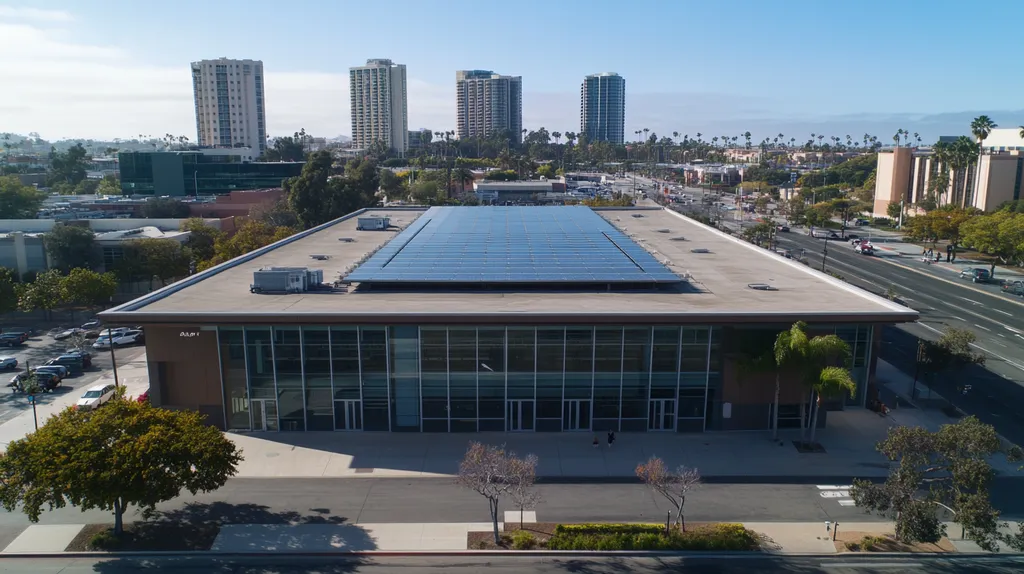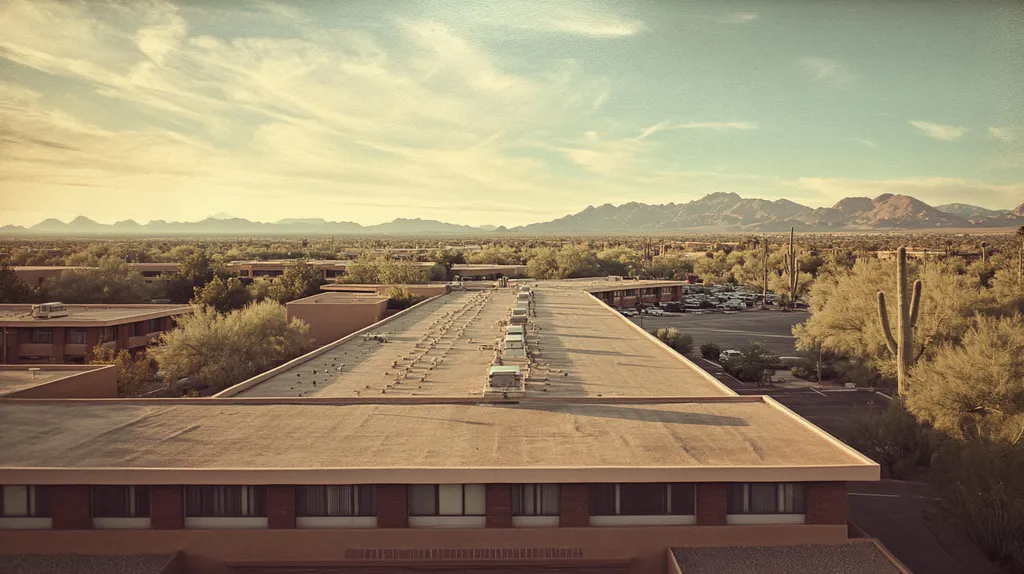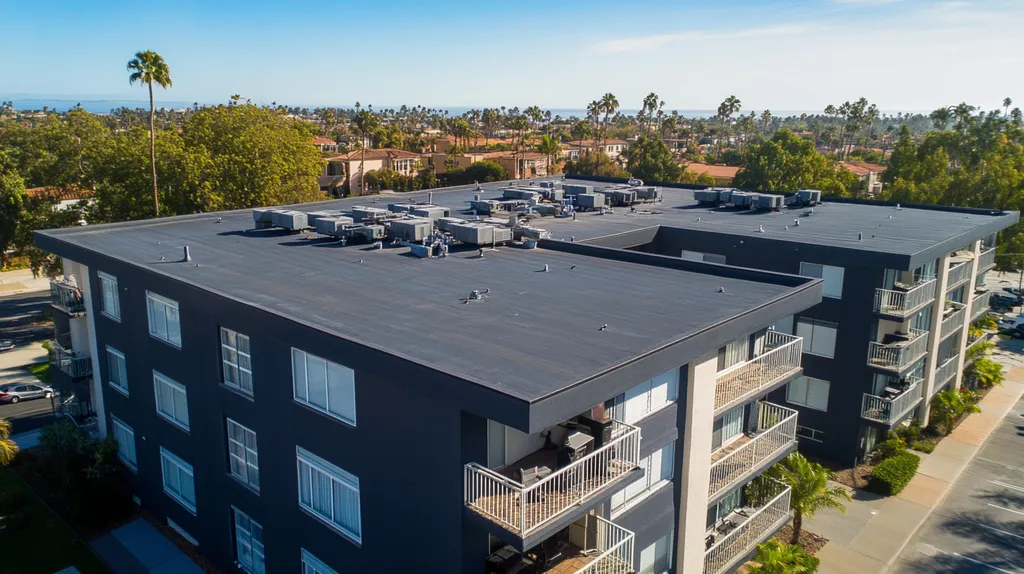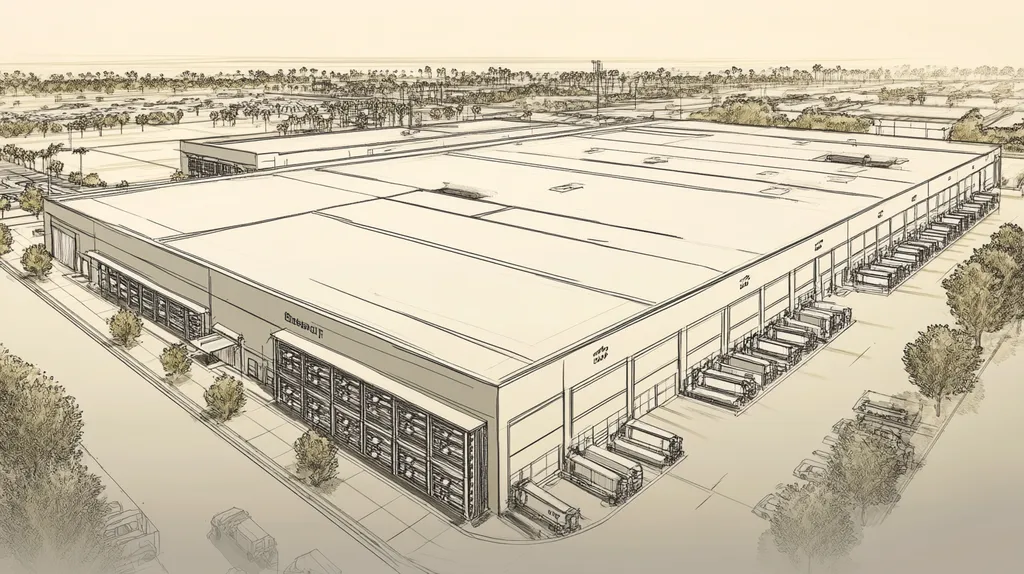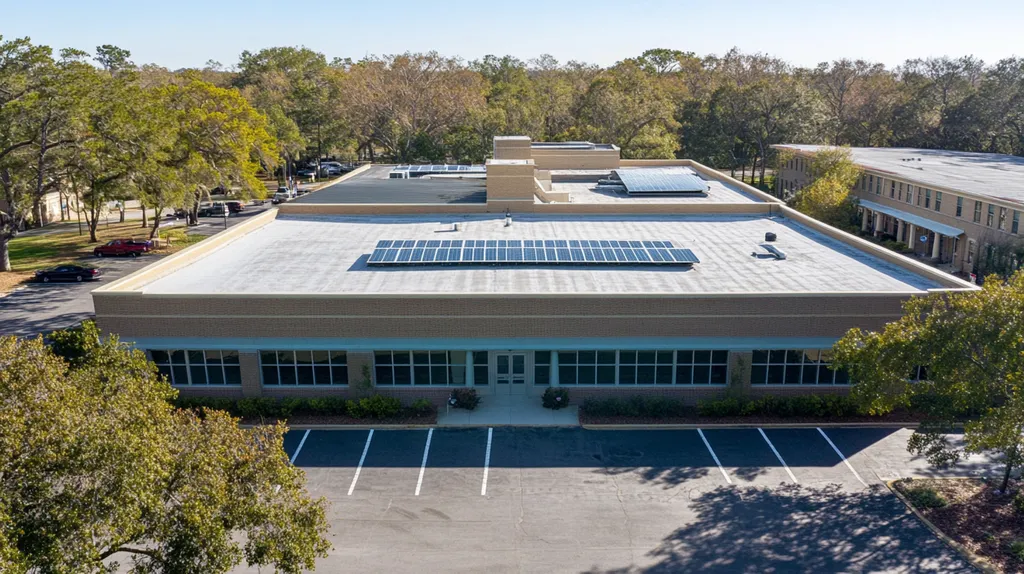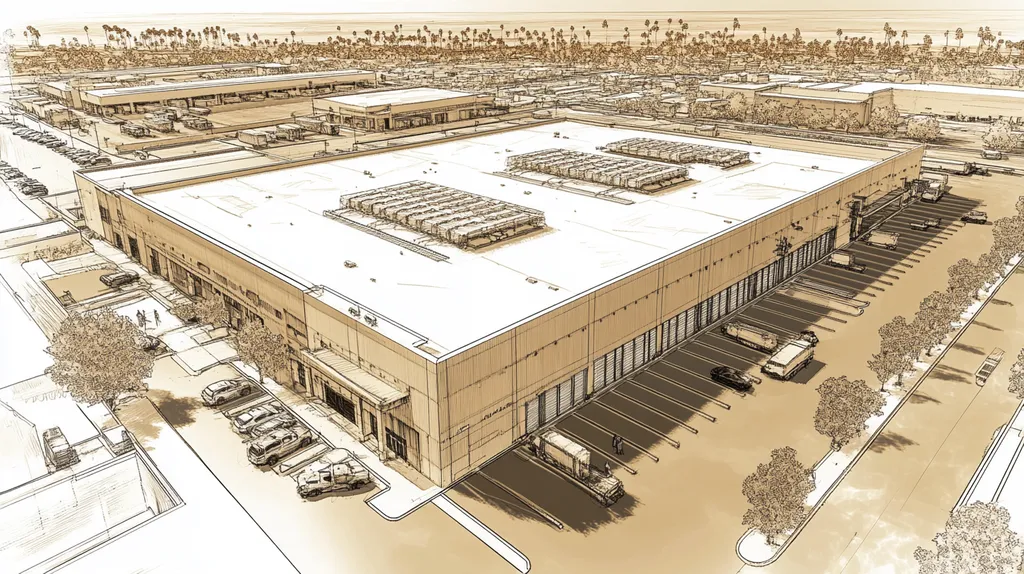Welcome to today’s Battle Royale featuring two roofing heavyweights: “Liquid Applied Membrane” in the east corner versus “Bituminous Coatings” in the west!
Tonight’s showdown pits these contenders against each other across six punishing rounds designed to test every aspect of their performance for Industrial Roof Drainage.
At stake? Millions in potential costs, decades of building protection, and the critical performance demands of modern commercial and industrial facilities.
Our professional judging panel will evaluate each round on technical merit, real-world performance, and value delivery. After all six rounds, we’ll declare our ultimate champion.
Ladies and gentlemen, facility managers and building owners… it’s time to rumble!
ROUND 1: INITIAL COSTS & INSTALLATION
When industrial roofing systems fail, the consequences can be catastrophic – from inventory damage to complete business shutdowns. Poor drainage leads to ponding water, which can add thousands of pounds of stress to roof structures. The choice between Liquid Applied Membrane and Bituminous Coatings impacts not just initial costs, but the long-term financial health of the facility.
Material Expenses
Material costs represent a significant portion of any industrial roofing project. Premium Liquid Applied Membranes typically cost 30-40% more per square foot than traditional Bituminous Coatings, creating immediate budget pressure for facility managers.
However, Liquid Applied Membranes offer seamless coverage and typically last 15-20 years with proper maintenance. Their advanced polymer formulations provide superior resistance to UV damage and thermal cycling.
Bituminous Coatings present an attractive initial price point but generally require replacement or significant repairs within 10-12 years. Their multi-layer application process can also result in weak points where water intrusion occurs.
ADVANTAGE: Bituminous Coatings for initial cost, but Liquid Applied Membrane for lifetime value.
Installation Complexity
The application process dramatically affects both labor costs and quality outcomes. Liquid Applied Membranes demand precise surface preparation and controlled application conditions, requiring specialized equipment and certified installers.
These membranes must be applied within specific temperature and humidity ranges, which can limit installation windows. However, their fluid application ensures complete coverage of complex roof geometries and penetrations.
Bituminous Coatings utilize familiar techniques that most roofing crews already know. Their traditional application methods allow for installation in a broader range of weather conditions.
ADVANTAGE: Bituminous Coatings
Project Timeline
Installation speed directly impacts facility disruption and overall project costs. Liquid Applied Membranes require multiple coats with specific cure times between applications, typically extending the project timeline by 25-40% compared to traditional methods.
The careful surface preparation needed for Liquid Applied Membranes adds additional time to the process. However, this investment in proper installation pays dividends in system longevity.
Bituminous Coatings can often be completed in a single phase, minimizing business disruption. Their faster installation reduces labor hours and allows facilities to resume normal operations sooner.
ADVANTAGE: Bituminous Coatings
ROUND 1 WINNER: BITUMINOUS COATINGS
ROUND 2: DURABILITY & LIFESPAN
Every year, industrial facilities lose millions in revenue due to roof failures and drainage issues. The choice between coating systems directly impacts not just immediate protection, but long-term facility resilience. With weather patterns becoming more extreme, selecting the right roofing system has never been more critical for protecting valuable assets and operations.
Weather Resistance Performance
Liquid applied membranes create a seamless, monolithic barrier that excels in preventing water infiltration. Their elastomeric properties allow them to expand and contract with temperature fluctuations without compromising integrity.
These membranes maintain flexibility even in extreme temperatures, ranging from -40°F to 180°F. Their chemical composition also provides superior UV resistance, helping prevent degradation from solar exposure.
Bituminous coatings provide robust initial protection but can become brittle over time. Their multi-layer application creates potential weak points at seams and transitions where water can eventually penetrate.
ADVANTAGE: Liquid Applied Membrane
Impact and Wear Resistance
Acrylic coatings provide excellent reflectivity and are economical to apply, but they gradually lose thickness due to weathering. They also require specific temperature conditions during installation and may fail in areas where water ponds. (source: Barrett Company)
Liquid applied membranes demonstrate superior resistance to foot traffic and maintenance activities. Their self-flashing capabilities around penetrations and equipment create durable, long-lasting seals.
Bituminous coatings show good initial durability but are more susceptible to mechanical damage. Their reduced flexibility makes them more prone to cracking and separation, particularly around roof penetrations.
ADVANTAGE: Liquid Applied Membrane
Maintenance Requirements
Liquid applied membranes typically require minimal maintenance beyond regular inspections. Their seamless nature eliminates many common failure points, reducing the need for repairs and touch-ups.
When repairs are needed, they can often be accomplished with simple recoating of the affected area. This characteristic makes maintenance more cost-effective and less disruptive to facility operations.
Bituminous coatings demand more frequent maintenance interventions. Their susceptibility to UV degradation and thermal cycling means regular recoating is necessary to maintain protection.
ADVANTAGE: Liquid Applied Membrane
ROUND 2 WINNER: Liquid Applied Membrane
ROUND 3: PERFORMANCE FACTORS
In today’s industrial environments, roof drainage failures can cascade into catastrophic operational disruptions. A single major leak can damage millions in equipment, halt production lines, and compromise worker safety. The stakes are particularly high in facilities with sensitive electronics, precision machinery, or temperature-controlled storage.
Understanding how different coating systems perform under real-world conditions is crucial for protecting these critical assets. The right choice between liquid applied membranes and bituminous coatings can mean the difference between reliable protection and costly failures.
Water Management Capability
The primary function of any industrial roof coating is directing water away from the structure. Liquid applied membranes create a continuous, seamless surface that naturally channels water toward drainage points without creating areas where moisture can collect.
These membranes maintain consistent thickness across the entire roof surface, eliminating the variations and irregularities that often trap water. Their molecular structure actively resists water absorption, providing an additional barrier against moisture intrusion.
Bituminous coatings rely on overlapping layers that can create subtle ridges and transitions. While these coatings provide good water resistance initially, their sectional nature can lead to areas where water movement is impeded.
ADVANTAGE: Liquid Applied Membrane
Surface Adhesion
Strong adhesion to the substrate is crucial for maintaining drainage patterns over time. Liquid applied membranes form a chemical bond with properly prepared surfaces, creating an inseparable layer that moves with the building structure.
This superior adhesion prevents water from migrating beneath the coating, even under persistent ponding conditions. The flexibility of these membranes allows them to maintain their bond despite building movement and thermal cycling.
Bituminous coatings typically rely on mechanical adhesion, which can weaken over time. Their reduced flexibility can lead to separation from the substrate, particularly around areas subject to movement or stress.
ADVANTAGE: Liquid Applied Membrane
Temperature Performance
Extreme temperatures can dramatically affect how well drainage systems function. Liquid applied membranes maintain their flexibility and performance characteristics across a wide temperature range, ensuring consistent water flow regardless of conditions.
These advanced polymers resist softening in high heat and remain flexible in cold, maintaining their crucial drainage properties year-round. Their thermal stability prevents the formation of cracks or channels that could disrupt proper water flow.
Bituminous coatings become more brittle in cold weather and can soften significantly in heat, potentially altering drainage patterns. These temperature-related changes can create new paths for water to pool or penetrate.
ADVANTAGE: Liquid Applied Membrane
ROUND 3 WINNER: Liquid Applied Membrane
ROUND 4: MAINTENANCE REQUIREMENTS
Industrial roof maintenance failures cost facilities millions annually in emergency repairs, equipment damage, and operational disruptions. A single delayed inspection or overlooked repair can cascade into catastrophic system failure. Understanding the maintenance demands of different coating systems is crucial for protecting valuable assets and ensuring continuous operations.
Inspection Frequency and Complexity
Liquid applied membranes require annual visual inspections focused primarily on mechanical damage from foot traffic or equipment servicing. Their seamless nature means fewer potential failure points to examine, significantly reducing inspection time and complexity.
These systems typically need professional assessment only every 24-36 months, depending on environmental conditions. When issues are found, they’re usually isolated and easily traced to specific impact points.
Bituminous coatings demand quarterly inspections due to their multi-layer construction and numerous seams. Each inspection must carefully examine overlaps, flashings, and transitions where coating layers meet.
ADVANTAGE: Liquid Applied Membrane
Repair Procedures
Liquid applied membrane repairs involve minimal surface preparation and can usually be completed with simple recoating of damaged areas. The chemical bond between new and existing material creates seamless repairs that maintain system integrity.
Most repairs can be completed in a single day, with immediate return to service once cured. The uniform nature of the system means repairs blend completely with existing coating.
Bituminous coating repairs require extensive preparation, including removal of damaged layers and careful matching of existing materials. Multi-layer application processes extend repair timelines and create new potential failure points at repair boundaries.
ADVANTAGE: Liquid Applied Membrane
Long-term Maintenance Costs
Liquid applied membranes demonstrate superior cost efficiency over time due to simplified maintenance procedures. Their monolithic surface eliminates the need for seam maintenance and reduces the frequency of major interventions.
The self-flashing characteristics around penetrations and equipment minimize common failure points that typically drive up maintenance expenses. UV-resistant formulations maintain protective properties longer, reducing recoating frequency.
Bituminous systems require regular recoating of high-stress areas and complete renewal of protective top coats every 3-5 years. Their susceptibility to UV degradation and thermal movement creates ongoing maintenance demands that significantly impact lifetime costs.
ADVANTAGE: Liquid Applied Membrane
ROUND 4 WINNER: Liquid Applied Membrane
ROUND 5: SUSTAINABILITY CREDENTIALS
Environmental impact has become a defining factor in industrial roofing decisions, with facilities facing increasing pressure to reduce their carbon footprint. Poor coating choices can increase energy consumption by up to 30% and contribute significantly to urban heat island effects. With new environmental regulations emerging yearly, choosing sustainable roofing solutions has become essential for long-term facility compliance and operational efficiency.
Life Cycle Impact
Sustainable roofing starts with manufacturing and extends through disposal, affecting both environmental impact and facility costs. Liquid applied membranes can often be installed directly over existing roof surfaces, eliminating the need for tear-offs and reducing landfill waste by up to 70%.
These membranes require fewer raw materials in their production and create minimal waste during installation. Their extended lifespan of 15-20 years further reduces the environmental impact of replacement cycles.
Bituminous coatings typically require complete removal of existing materials, generating significant waste. Their petroleum-based composition and shorter service life result in more frequent replacements and greater environmental burden.
ADVANTAGE: Liquid Applied Membrane
Energy Efficiency
Acrylic roof coatings provide excellent UV protection and reflectivity, helping facilities reduce cooling costs significantly. Their water-based formulation and smooth finish contribute to better thermal performance, though they may require more frequent reapplication in challenging environments. (source: Embry’s Roofing)
Liquid applied membranes maintain their reflective properties throughout their service life, reducing cooling loads by up to 30%. Their seamless application eliminates thermal bridges that can compromise building energy efficiency.
Bituminous coatings absorb more solar radiation, increasing roof surface temperatures and HVAC energy consumption. Their dark color and thermal mass can contribute significantly to building heat gain.
ADVANTAGE: Liquid Applied Membrane
Environmental Compliance
Modern facilities must navigate increasingly strict environmental regulations while maintaining operational efficiency. Liquid applied membranes often contain low or zero VOCs, helping facilities meet air quality requirements and achieve green building certifications.
These systems can contribute to LEED points through reduced energy consumption and minimal environmental impact. Their recyclable components and non-toxic formulations align with sustainable building practices.
Bituminous coatings face growing scrutiny due to their petroleum-based composition and higher VOC content. Their disposal often requires special handling, increasing both cost and environmental impact.
ADVANTAGE: Liquid Applied Membrane
ROUND 5 WINNER: Liquid Applied Membrane
ROUND 6: SPECIALIZED APPLICATIONS
Industrial roofing faces unprecedented challenges as facilities become more complex and weather patterns grow increasingly extreme. A single drainage failure in specialized areas can result in millions of dollars in equipment damage and operational losses. Understanding how different coating systems perform in unique scenarios is crucial for protecting high-value assets and maintaining business continuity.
Adaptability to Unique Roof Designs
Modern industrial facilities often feature complex roof geometries, including multiple penetrations, irregular shapes, and varying slopes. These architectural challenges demand coating systems that can maintain consistent performance across all surface variations.
Liquid applied membranes excel in conforming to irregular shapes and penetrations, creating a continuous, seamless barrier. Their fluid application ensures complete coverage of complex details and transitions, maintaining drainage patterns even in challenging areas.
Bituminous coatings struggle with complex geometries due to their sheet-based application method. Seams and overlaps at transitions create potential weak points where water can collect or penetrate.
ADVANTAGE: Liquid Applied Membrane
Resistance to Chemical Exposure
Industrial environments often expose roofing systems to harsh chemicals, process emissions, and corrosive substances. These environmental factors can rapidly degrade conventional roofing materials, compromising drainage performance and structural integrity.
Liquid applied membranes offer superior chemical resistance through their advanced polymer formulations. Their monolithic surface prevents chemical infiltration and maintains performance even under sustained exposure to industrial contaminants.
Bituminous coatings provide limited chemical resistance and can break down when exposed to common industrial chemicals. Their multi-layer construction creates additional opportunities for chemical attack at seams and overlaps.
ADVANTAGE: Liquid Applied Membrane
Thermal Expansion Management
Industrial roofs experience significant thermal cycling, especially in facilities with high-temperature processes or extensive HVAC equipment. These temperature fluctuations can stress coating systems and disrupt drainage patterns.
Liquid applied membranes maintain flexibility across a wide temperature range, absorbing building movement without compromising performance. Their elastic properties prevent cracking and separation even under extreme thermal cycling.
Bituminous coatings become brittle in cold conditions and soft in heat, leading to potential failure points. Their reduced flexibility makes them more susceptible to thermal stress-induced damage.
ADVANTAGE: Liquid Applied Membrane
ROUND 6 WINNER: Liquid Applied Membrane
AND THE WINNER IS…
After six grueling rounds of technical evaluation, we have our verdict, and it’s a decisive victory! With an impressive 5-1 round advantage, LIQUID APPLIED MEMBRANE claims the championship belt in this industrial roof drainage showdown!
The champion dominated through superior durability, performance, maintenance efficiency, sustainability, and specialized application capabilities. Its seamless application, chemical resistance, and adaptive properties proved unstoppable in protecting industrial assets.
But don’t count BITUMINOUS COATINGS out completely! This veteran contender still packs a punch in Round 1, offering faster installation and lower initial costs. For facilities with tight budgets and shorter-term planning horizons, it remains a viable contender.
IMPORTANT NOTICE: Every facility faces unique challenges. Local climate conditions, building specifications, and operational requirements can significantly impact coating performance. This analysis provides general guidance but cannot account for all variables. Always consult qualified roofing professionals who can evaluate your specific situation before making final decisions.
Ladies and gentlemen, in the high-stakes world of industrial roofing, there’s no substitute for matching your facility’s specific needs with the right system’s strengths. Choose wisely – because when drainage failure strikes, there are no second rounds!
FREQUENTLY ASKED QUESTIONS
Q. What are initial costs for commercial roof coatings?
A. Initial costs for commercial roof coatings vary significantly between options. Liquid Applied Membranes typically have higher upfront costs but may provide greater long-term value compared to Bituminous Coatings. Facility managers must consider both installation costs and the life expectancy of the coatings when budgeting for roofing projects.
Q. How does durability compare for industrial roof coatings?
A. Durability is a critical factor in choosing coatings for industrial roofs. Liquid Applied Membranes generally outperform Bituminous Coatings in terms of long-term protection against UV damage and temperature fluctuations. Selecting a durable solution helps prevent costly repairs and operational disruptions due to roof failures.
Q. What are the performance factors for commercial roof coatings?
A. Performance factors include water management, adhesion, and temperature resistance. Liquid Applied Membranes maintain superior water drainage and adhesion compared to Bituminous Coatings. Understanding these factors can greatly help in selecting a suitable roofing system that will withstand the demands of industrial environments.
Q. How often should maintenance be performed on industrial roofs?
A. Maintenance frequency crucially impacts the longevity of industrial roofs. Liquid Applied Membranes typically require annual inspections, while Bituminous Coatings may necessitate quarterly checks. Regular maintenance helps identify minor issues before they develop into major problems, preserving the roof’s condition and maximizing its lifespan.
Q. What are the sustainability benefits of roof coatings?
A. Sustainable roofing solutions significantly reduce environmental impact. Liquid Applied Membranes minimize waste during installation by enabling direct application over existing roofs. Their energy efficiency also promotes lower utility costs, contributing towards a reduced carbon footprint for commercial properties throughout their life cycle.
Q. Can industrial roof coatings adapt to specialized applications?
A. Adaptability is crucial for coatings used in specialized scenarios. Liquid Applied Membranes excel in conforming to intricate shapes and penetrate numerous elements seamlessly. This flexibility protects assets in areas with unique architectural challenges. Bituminous Coatings, in contrast, may struggle with such complexities, creating vulnerabilities.
Q. What is the expected lifespan of commercial roof coatings?
A. Lifespan of roofing coatings is vital for long-term planning. Liquid Applied Membranes generally last between 15-20 years with proper maintenance, while Bituminous Coatings often need replacement every 10-12 years. Choosing a product with a longer lifespan helps reduce future replacement costs and minimizes operational disruptions.

